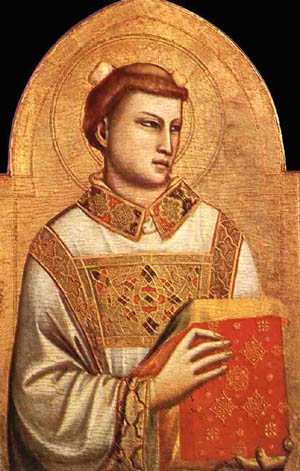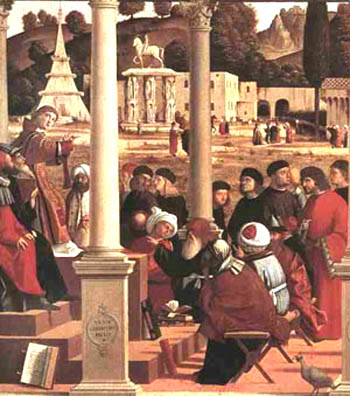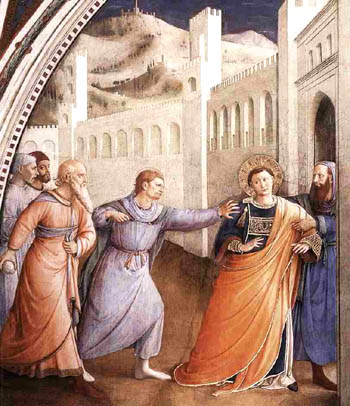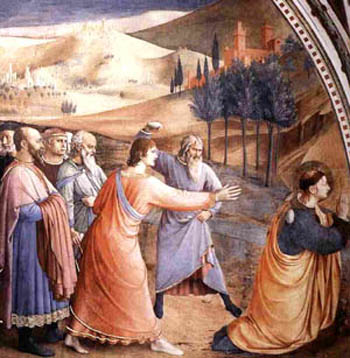 |
The Saint of the Day
St. Stephen – December 26
Prof. Plinio Corrêa de Oliveira
Biographical selection:
“Now Stephen, full of grace and fortitude, did great wonders and miracles among the people.

St. Stephen by Giotto |
“Now there arose some of that which is called synagogue, of the Libertines, and of the Cyreneans, and of Alexandrians, and those of Cilicia and Asia, disputing with Stephen. And they were not able to resist the wisdom and the spirit that spoke ….
“Now hearing these things, they were cut to the heart, and they gnashed with their teeth at him. But he being full of the Holy Ghost, looking up steadfastly to Heaven, saw the glory of God, and Jesus standing at the right hand of God. And he said: Behold I see the heavens opened, and the Son of man standing at the right hand of God.
“And they, crying out with a loud voice, stopped their ears, and with one accord rushed violently upon him. And casting him out of the city, they stoned him and the witness laid down their garments at the feet of a young man, whose name was Saul.
“And they stoned Stephen, invoking and saying: Lord Jesus, receive my spirit.
“And falling on his knees, he cried out with a loud voice, saying: Lord, lay not this sin to their charge. And when he had said this, he fell asleep in the Lord” (Acts 6:8-10; 7:54-59).
Comments of Prof. Plinio:
The text is so beautiful that almost every phrase deserves a commentary. The scene develops in successive steps, each one with its own character.
The first step presents St. Stephen as doing wonderful things. The imponderables of the language of Scriptures transmit the picture of a virginal man, and then the text adds that he was full of grace and strength. To describe St. Stephen, the Holy Ghost utilized the same expression – “full of grace” – that the Archangel Gabriel used to greet Our Lady, which is a great honor for St. Stephen. He was a man with the plenitude of strength, and also the plenitude of virtue and grace that acted in him.

St. Stephen disputing with Jews from various synagogues in Jerusalem by Vittore Carpaccio

Filled with hatred for his goodness,
they determine to murder him

The stoning of St. Stephen, by Fra Angelico |
In the second step, we learn about the people to whom he was preaching. He was working his miracles in the midst of those apostate Jews. Jerusalem was a convergence point for Jews from many parts of the world. This is why Scriptures specifies the different synagogues of peoples – the Libertines, Cyreneans, Alexandrians, and so on. Witnessing the miracles of St. Stephen, these people hated him and began to resort to chicaneries and sophisms in order to embarrass him.
In the third step, we see his disputation with the Jews. He responded so well to his adversaries that the polemic begun by the Jews backfired on them. They became confused and dumbfounded. Prior to this, they could not support his miracles, and after he argued, they could not support his superb argumentation. Their hatred increased to the degree St. Stephen manifested the admirable aspects of his soul.
In the fourth step, that hatred increased and the people who opposed St. Stephen began to gnash their teeth in fury. What was the object of that hatred? It was goodness, in and of itself. They hated the good because the good is good, and not for any other reason. A person who does not understand reality would say: "No, they didn’t like him because he made this or that small error when he was explaining his topic, or he lacked the skill to address a particular matter." Such a person has an erroneous interpretation of reality.
Those Jews understood perfectly what St. Stephen was saying and doing. They saw that those things were marvelous, and they hated those things because they were good. The nature of evil is such that it attacks good because it is good. This is the perfidy of evil. This is the essence of its iniquity. The more good and truth manifest themselves, the more the sons of darkness hate them.
That was the same people who had preferred Barrabas to Our Lord, and had called for His death. This is the iniquity of evil and the malice of sin. This malice is different from that of a person who commits a sin. This kind of malice comes from one who has rejected the good and loves the evil that he does.
In the fifth step, after closing the polemic, St. Stephen raised his eyes to Heaven, and gave testimony to the divinity of Our Lord, Whom he was seeing in a vision. He spoke in a way that left no room for doubt that he was speaking the truth. His words reflected the Holy Ghost Who was filling his soul. He was experiencing a mystical ecstasy, and this supernatural reality was made apparent to those around him.
Someone could object that it would have been more prudent and efficacious for St. Stephen to have fled the challenge. He would have lived longer and perhaps converted those men. The answer is that St. Stephen was filled with the Holy Ghost when he responded as he did. Therefore, he acted correctly.
Also at the beginning of the disputation, it was not certain that the mob would murder him. If those people had corresponded to grace, they would have converted. He acted as he did to convert them. He showed them ever greater wonders. He was trying to touch those souls and conquer them for the good. But they refused all those graces. As the episode reached its apex, they made the decision to stone him. He used the perfect method of apostolate: he tried to illuminate their intelligences and move their hearts.
The sixth step is the murder. Those present pretended to be shocked by the supposed blasphemous words of St. Stephen, and covered their ears. At the same time, they decided to kill him. They left their mantles next to a man called Saul, who would be the future St. Paul according to many interpreters, and went to stone the Saint.
Like a second Lamb of God, he stood alone, looking up toward Heaven, blood pouring from his wounds, but serene and saying the prayer: “Lord Jesus, receive my spirit.” You can imagine the impression this made on the spectators.
Then, as the stones continued to hit him, he fell onto his knees and asked Our Lord to forgive those criminals. Finally, “he fell asleep in the Lord.” Everything was finished. His body was covered with blood and wounds, but on his face was a tranquil expression. He had entered into the sleep of the just. His martyrdom was consummated, and his soul flew to Heaven. We see a scene truly worthy of being the first martyrdom of the Church, described with the inspired language of Scriptures.


  | | Prof. Plinio Corrêa de Oliveira | |
The Saint of the Day features highlights from the lives of saints based on comments made by the late Prof. Plinio Corrêa de Oliveira. Following the example of St. John Bosco who used to make similar talks for the boys of his College, each evening it was Prof. Plinio’s custom to make a short commentary on the lives of the next day’s saint in a meeting for youth in order to encourage them in the practice of virtue and love for the Catholic Church. TIA thought that its readers could profit from these valuable commentaries.
The texts of both the biographical data and the comments come from personal notes taken by Atila S. Guimarães from 1964 to 1995. Given the fact that the source is a personal notebook, it is possible that at times the biographic notes transcribed here will not rigorously follow the original text read by Prof. Plinio. The commentaries have also been adapted and translated for TIA’s site.
|
Saint of the Day | Home | Books | CDs | Search | Contact Us | Donate

© 2002- Tradition in Action, Inc. All Rights Reserved
|
 |

|